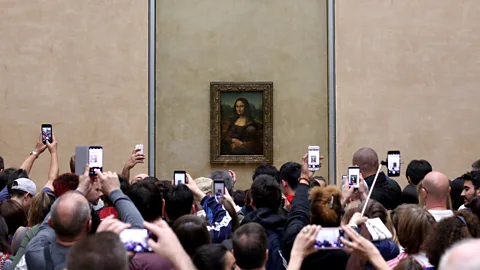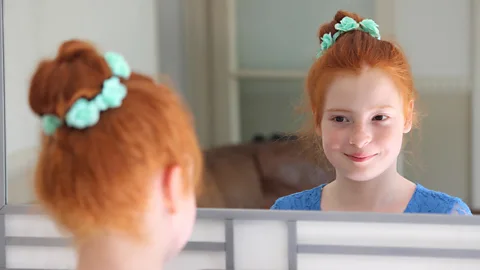The people who cannot smile
 Getty Images
Getty ImagesSmiling is a fundamental part of how we interact with other people, but what if you were not able to do it?
Kevin Portillo practises smiling every day at home. Usually after brushing his teeth. Or when stopping by the bathroom, or anywhere with a mirror.
He hooks an index finger into each side of his mouth and pulls gently upward. He puckers his face into a kiss, then opens wide into an O, trying to limber up his facial muscles. He practises both the Mona Lisa – slight, closed-lip – and a wide, toothy smile.
At least, he’s supposed to do his exercises every day. Being 13, he sometimes forgets, though he understands their importance.
You might also like:
“I need to stretch my cheeks,” he says. “I do it for a couple minutes. I have to do it every single day.” He exercises so much that his jaw sometimes hurts.
Kevin was born in New Jersey with a rare malignant vascular tumour, a kaposiform haemangioendothelioma, covering the left side of his face, squeezing shut his left eye and pushing his nose to the right. Immediately after his birth, doctors whisked him away to another hospital in another state – the Children’s Hospital of Philadelphia. His mother didn’t see him again until he was eight days old.
The doctor told Kevin’s parents that the chance of him surviving was slim.
But survive he did. However, the large tumour and the damage from its treatment prevented him from being able to do one of the most fundamental things humans do.
Smile.
On a physical level, a smile is clear enough. There are 17 pairs of muscles controlling expression in the human face, plus a singular muscle, the orbicularis oris, that runs in a ring around the mouth.
 Natalie Keyssar
Natalie KeyssarThe basic upward curving smile is achieved primarily by two pairs of muscles known as the zygomaticus major and minor. These connect the corners of the mouth to the temples, tugging lips upward – often accompanied, depending on the underlying emotions and thoughts, by the levator labii superioris, raising the upper lip, and other muscles of the face.
It is when we leave the realm of physiognomy, however, that the smile becomes enigmatic. This contraction of various facial muscles resonates across the entire arc of human history, from the grinning Greek kouros sculptures of 2,500 years ago right up to emoji, those little images that pepper our online communications.
There are differences in gender (generally, women smile more) and culture. Smiles are definitely communicative – people smile more when in public than they do when alone, and more when interacting with others than when not.
Scientists have shown that smiles are far easier to recognise than other expressions. What they don’t know is why.
“We can do really well recognising smiles,” says Aleix Martinez, a professor of electrical and computer engineering at Ohio State University and founder of its Computational Biology and Cognitive Science Lab.
“Why is that true? Nobody can answer that right now. We don’t know. I can show you an image for just 10 milliseconds and you can tell me it’s a smile. It does not work with any other expression.”
Bafflingly, fear takes an exposure time of 250 milliseconds to recognise – 25 times as long as a smile. “Recognising fear is fundamental to survival, while a smile…” muses Martinez. “But that’s how we are wired.”
Other studies have shown that smiling faces are also judged as more familiar than neutral ones. Scientists such as Martinez theorise that smiles – as well as frowns and other facial expressions – are remnants of humanity’s distant pre-linguistic heritage. Human language started developing as far back as 100,000 years ago, but our facial expressions reach back further still, perhaps as far as some of our earliest human ancestors.
“Before we could communicate verbally, we had to communicate with our faces,” Martinez says.
Interpreting the nuances in a smile is a challenge whether dealing with art history or interpersonal encounters or the cutting edge of artificial intelligence. A 2016 study, for example, questioned thousands of people in 44 cultures about sets of photographs of eight faces – four smiling, four not.
 Getty Images
Getty ImagesMost of these people deemed the smiling faces to be more honest than the non-smiling ones. This difference was huge in some countries, such as Switzerland, Australia and the Philippines, but small in others, such as Pakistan, Russia and France. And in a few countries, such as Iran, India and Zimbabwe, there was no trustworthiness benefit to smiling at all.
Why? That question is also complicated, but in essence, the researchers concluded it has to do with whether a society is set up so that its members assume that other people are dealing with them honestly. “Greater corruption levels decreased trust granted toward smiling individuals,” the authors concluded.
That attitude harks back to a very old view of smiling being opposed to pious solemnity. When piety was an overarching value, smiles were, well, frowned upon as the precursor of laughter, which was held in true disdain. Prior to the French Revolution, broad smiles in art were overwhelmingly the realm of the lewd, the drunk and the boisterous lower classes.
Eastern religions, however, often use the smile to denote enlightenment. The literal name of the thousand-year-old Flower Sermon, which describes the origin of Zen Buddhism, is “Pick up flower, subtle smile”. The Buddha and various religious figures were depicted with serene smiles, though the original Buddhist texts are as devoid of smiling as Western scripture. Jesus weeps but never smiles.
Nor did Kevin Portillo, not fully. At five weeks’ old he was already a week into chemotherapy with vincristine, an anticancer drug so powerful it can cause bone pain and skin rashes. Doctors warned his mother, Silvia Portillo, that the treatment might leave him blind, or deaf, or unable to walk.
Whether stunted due to the tumour or killed by the chemotreatment, Kevin’s seventh cranial nerve withered. That nerve originates at the brainstem then branches out across the face. It is susceptible not only to tumours, as in Kevin’s case, but also to rare conditions such as Moebius syndrome, a congenital facial paralysis caused by missing or stunted cranial nerves. You can’t smile, frown, or move your eyes from side to side.
“You essentially have a mask on your face,” says Roland Bienvenu, 67, a Texan with Moebius syndrome.
Without being able to smile, others “can get the incorrect impression of you”, he says. “You can almost read their thoughts. They wonder, ‘Is something wrong with him? Has he had an accident?’ They question your intellectual ability, think maybe he’s got some intellectual disability since he’s got this blank look on his face.”
The challenges stemming from lack of a smile are frequently compounded. When people have a medical condition severe enough to keep them from smiling, other difficulties tend to be involved.
“He was different than the other kids,” says Silvia of her son Kevin. “He was fed for four years through the G-tube in his stomach. He wasn’t able to have a normal life, because every few hours he had to be connected to the machine to be fed.” Little kids, being curious, would look and ask what happened to him, she says.
 Getty Images
Getty ImagesBut even once Kevin was able to eat food, go to school and enjoy usual childhood pastimes – he became passionate about soccer and playing the drums – he still felt the tremors of having a half-smile in a world solidly established upon “a cultural expectation of pearly perfection”, as Richard Barnett writes in his book The Smile Stealers.
“I couldn’t smile on my left, I only smiled on my right,” says Kevin. “My smile was weird… people kept asking what happened to me, why I'm like this. I keep telling them I was like this when I was born.”
Facial paralysis carries no telltale equipment, unlike some other disabilities, and is rare enough that the unaffected population is not generally familiar with the conditions that cause it, whether congenital or appearing later in life.
One of the latter is Bell’s palsy, an inflammation of the sheathing around the facial nerves on one side that paralyses half the face, causing the eye and corner of the mouth to droop. It usually strikes men and women between the ages of 15 and 60.
In most cases temporary, Bell’s palsy generally slowly goes away as mysteriously as it arrives. Doctors suspect it is caused by a viral infection. There are also traumatic events – car wrecks, sporting accidents – that damage nerves and muscles in the face, plus congenital irregularities such as cleft palate.
A common condition that can also affect the smile is stroke. A sagging smile or face drooped on one side is one of three signs that a person has had a stroke and needs immediate emergency care (the other two are weakness or numbness in one arm and slurred or garbled speech).
While losing a smile is a serious blow at any age, it can have a particular impact on younger people, who are starting out, forming the bonds that will carry them through the rest of their lives.
“It’s a huge problem,” says Tami Konieczny, supervisor of occupational therapy at the Children’s Hospital of Philadelphia (CHoP). “When you look at somebody, the first thing you see is their face, their ability to smile or not smile, or an asymmetrical smile. It’s your social world.
“If someone can’t read your facial expressions, then it’s difficult to be socially accepted. It’s hugely devastating for kids. I had kids photoshopping their pictures. They are taking mirror images of their good side and copying it, photoshopping their own pictures before posting them to social media.”
 Getty Images
Getty ImagesPhotoshopping might work on Facebook. But fixing a smile bisected by nerve damage and subsequent muscle loss is far more complicated. Sometimes, it requires multi-stage plastic surgery spread out over a year or more.
“It’s incredibly important to be able to interact with humans on a face-to-face basis,” says Ronald Zuker, a Canadian plastic and reconstructive surgeon who pioneered facial reanimation procedures. “If you don’t have the ability to smile, you are at a disadvantage. People cannot understand your inner emotions. They mistake your appearance for being disinterested, or not too bright, or not very involved in the conversation.”
Still, some parents prefer to wait until their children are older and can participate in the decision.
“If families want to wait, that’s perfectly fine,” says Zuker. “Sometimes when a kid is nine or 10 they look in the mirror and say, ‘You know, I really want this surgery.’ That’s the time to do it.”
Which is what happened with Kevin. He was doing well, “even with that scar on his face, has always been popular at school”, says his mother. “He’s always been a happy kid.”
But there were kids that made fun of him, she says. One day when he was about nine, he was sad. “I said, ‘What happened to you?’ He said, ‘Some kids, they’re not my friends. They laugh at me because I look funny.’ It was really hard for us as parents.”
At age 10, Kevin told his parents that he wanted to do what most people do without giving it a second thought. He knew it would be a long, painful, difficult procedure, but it was one he wanted to undergo.
In October 2015, Phuong Nguyen, a plastic surgeon and reconstructive surgeon at CHoP, began work by removing a section of sural nerve from Kevin’s right ankle and attaching it to the working right side of his face, running it underneath his upper lip, to the paralysed left. He then let it regrow for almost a year, the nerve fibres advancing about a millimetre a day (about 24,000 times slower than a snail’s pace).
During that time, doctors would periodically tap areas of Kevin’s cheek, to see if the nerve was taking. “When it tingles, you know the nerve is growing,” says Nguyen.
 Getty Images
Getty ImagesRemoving that nerve did cause a small patch of skin on Kevin’s ankle to go numb. But as he was still growing, the numb patch began to shrink as the neural network took over its function.
Once Nguyen was certain the nerve was in place and functioning, it was time for the second stage of the surgery.
One morning in August 2016, he took a purple marker and drew a pair of parallel lines, marking the location of a prime artery, and an arrow: the vector Kevin’s smile would take.
Nguyen removed a 12cm (4.8in) segment of muscle, along with a section of artery and vein, from the inside of Kevin’s left thigh, securing it in place with a customised split that hooked into Kevin’s mouth.
Over the next year, Kevin began to get motion on the left side of his mouth.
“It’s really kind of a magical thing,” says Nguyen. “We do this procedure, a number of hours and effort, using not a small amount of resources. We don’t know if it works or not.
“I saw him post-operatively within the first couple of weeks, he looked like he had this big bulgy thing in his cheek. Nothing was moving. All of a sudden, he was smiling. It was a really incredible moment.”
Kevin needed regular occupational therapy sessions to get to where he is today. He performs exercises and puts on purple latex gloves to pull at the inside of his cheek. One exercise involves putting a surface EMG – an oblong black sensor that reads electrical activity in the muscle – onto Kevin’s left cheek so he can play video games by smiling and relaxing.
Physical rehabilitation is the part of the surgical process that often gets overlooked, but it can make the difference between success and failure.
“It’s huge, particularly with facial palsy,” says Nguyen. “You can do technically very sound surgery on two completely different patients and have two completely different outcomes based on how involved they are with their own therapy.”
How does Kevin feel about being able to fully smile after a lifetime of not being able to?
“I do it automatically,” says Kevin. “Sometimes when somebody says a joke. It actually feels great now. Before it felt weird to not smile. Smiling with both sides of my mouth at same time, I feel I’m one of the other people who smiles right.”
 Getty Images
Getty ImagesHis mother remembers the moment she noticed.
“We were at the table, we were eating,” says Silvia. “And then we said, ‘Kevin, are you moving there?’”
And how does his new smile affect Kevin’s life?
“Before, I was actually shy,” he says. “Right now, I’m less shy, more active.”
“I used to have trouble expressing my emotions. Now people know if I’m smiling or laughing. When I laughed, before, I laughed weird. And right now, they know, bit by bit, that I was trying to smile, I was expressing my laughter and my smile. When I play soccer, and score a goal, I’m happy. I’m smiling, to tell everybody I scored.”
--
This is an edited version of an article originally published by Mosaic, and is reproduced under a Creative Commons licence. The photographs fall outside of this licence and remain copyrighted as indicated.
If you liked this story, sign up for the weekly bbc.com features newsletter, called “If You Only Read 6 Things This Week”. A handpicked selection of stories from BBC Future, Earth, Culture, Capital, and Travel, delivered to your inbox every Friday.
